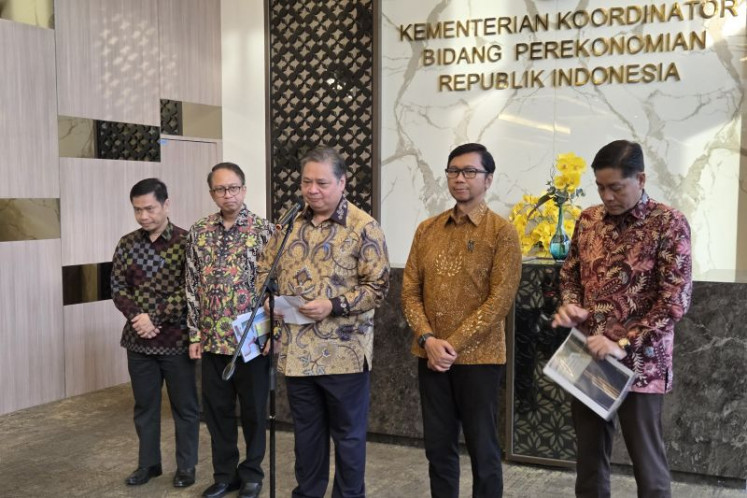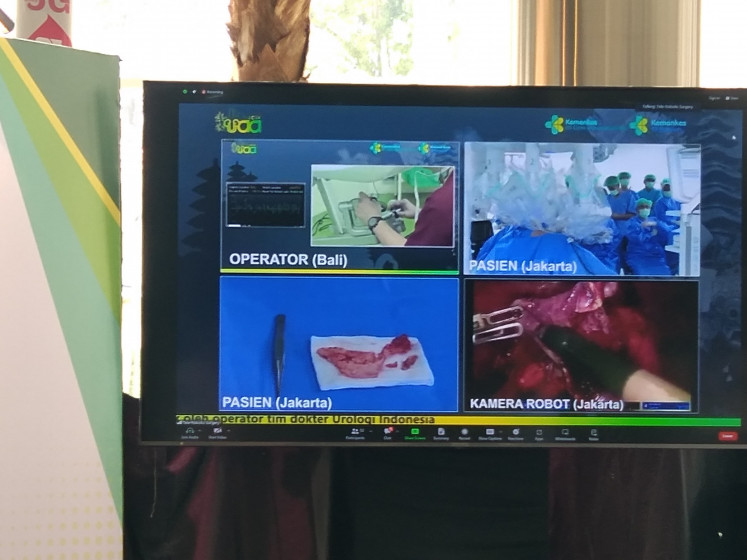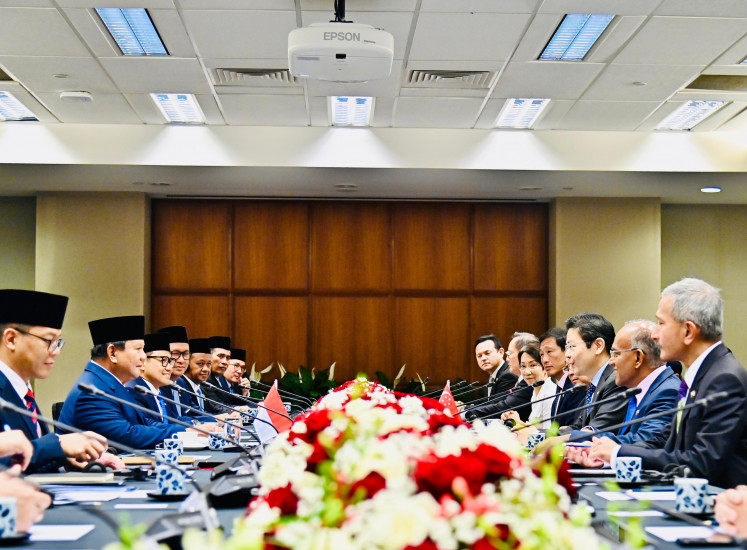Popular Reads
Top Results
Can't find what you're looking for?
View all search resultsPopular Reads
Top Results
Can't find what you're looking for?
View all search resultsSword stories: Struggle of Islam
Chinese connection: The Az Zafra bamboo bow (center), between the bow cover, staff and sandals, is the only of the Prophet Muhammadâs possessions that originated in China
Change text size
Gift Premium Articles
to Anyone

C
span class="caption">Chinese connection: The Az Zafra bamboo bow (center), between the bow cover, staff and sandals, is the only of the Prophet Muhammad's possessions that originated in China.
In countless efforts to defend Islam through wars, swords have become among the historical items that one can learn from.
Twenty-three replicas of various swords that belonged to Prophet Muhammad and his Sahabat (companions) were on display recently in an exhibition held at Skodam V Brawijaya Hall in Malang, East Java.
The original swords, which were utilized in many wars as part of the Prophet's struggle on behalf of Islam, are housed in the Topkapi Museum in Istanbul, Turkey.
The seven-day exhibition was aimed at educating people who may still think that Islam rose from violence, said exhibition manager Bagus Dwi Pujilaksono. 'The wars that had happened were a last resort in self-defense against people who rejected Islam,' he added.
The exhibition, which runs until July 14, also features replicas of some of the Prophet's possessions such as sandals, a bow and a staff.
Bagus said that the Turkish-made replicas were the same size and weight as the originals. Two replicas were of those weapons used by the Prophet, while the remaining belonged to his companions.
He further said that, according to books he had read, a great number of Islamic cultural heritage items, including the sword collection, had been preserved since the Abbasid Caliphate, the third of the Islamic caliphates to succeed Prophet Muhammad, in Baghdad.
However, due to the Mongol invasion that caused the fall of Baghdad in 1258, most of the historical collections were transported to Turkey to avoid destruction and looting.
The two replicas of the Prophet's swords are called al-Ma'thur and al-Qadib.
Al-Ma'thur, also known as 'Ma'thur al-Fijar', is the sword that was owned by the Prophet before he received his first revelations in Mecca. The sword was given to him due to the will of his father. When Prophet Muhammad migrated from Mecca to Medina, the sword remained with him until it was transferred to Ali bin Abi Talib, along with other tools of war. The length of the sword's blade is 99 centimeters. The handle is made of gold in the shape of two serpents, and is encrusted with emeralds and turquoise. Near the handle is a Kufic inscription that reads 'Abdullah bin Abdul-Muttalib'.

Al-Qadib is a thin-bladed sword which is said to resemble a rod. It was a sword of defense or companionship for the traveler but not used in battle. Written on the side of the sword in silver is the inscription: 'There is no god but God, Muhammad the apostle of God ' Muhammad b. Abdallah b. Abd al-Muttalib'. There are no indications from any historical sources that this sword was used in battle. It stayed in the house of the Prophet and was only used later by the Fatimid caliphs. The sword is 100 centimeters in length and has a scabbard of dyed animal hide.
What is also interesting from the exhibition is the Prophet's bamboo bow, which is called Az-zafra, or 'the Yellow'.
A source mentions that Utsman bin Affan, Ja'far bin Abi Thalib, Abu Waqas and the Prophet's other companions moved to the land of Habasyah (Ethiopia), which was ruled by King Najasi (Negus), who later embraced Islam, said Bagus.
The companions, along with King Najasi, sailed off to China during the rule of the Sui Dynasty in 581-618 and brought home a yellow bamboo stick, which was later made into a bow.
'The bow was the Prophet's only belonging that came from China,' said Bagus.
While most of the displayed replicas and collection were well covered, visitors were allowed to touch and take a photo with the replica of the legendary sword Zulfiqar, which was owned by Ali bin Abi Thalib, the fourth and last of the Righteous Caliph.
Historically, it was frequently depicted as a scissor-like double-bladed sword on Muslim flags. Muslim weapons are commonly inscribed with a quote mentioning Zulfiqar, and Muslim swords are at times made with a split tip in reference to the unique sword.
As a reliable companion of Prophet Muhammad, Ali was known as a man who had no fear in fighting, especially against anyone who intended to attack the Prophet. Nevertheless, behind the rough facade, Ali was an honest gentleman, a successor of Caliph Utsman bin Affan.
Ali's sword was 100 centimeters long and four kilograms in weight. It came with a yellowish gold sheath.
Visitors had to hold the replica with two hands to keep it steady.
'You can imagine how big Ali bin Abi Thalib was, or Arabs in general, who at that time could hold and swing the sword with one hand only,' said Bagus.

Other replica swords on display from the Prophet's companions included those that belonged to the first two of the Righteous Caliph, Abu Bakar Ash Shiddiq and Umar bin Khattab, and companions Khalid bin Walid, Dhirar bin Azwar, Zubayr bin Awwam, as well as a sword of the Prophet's great grandson, Ali Zainal Abidin.
A scholar in constitutional law from Brawijaya University, Isrok, said that the swords were not used as a symbol of violence for Islam to spread its teachings. 'Islam is rahmatan lil'alamin, which means a blessing for the whole world and its contents,' said the professor.
Instead, Isrok, who is also a cleric, said that the sword was a symbol of firmness from a leader as perfectly portrayed in Umar's story.
Isrok said that one day Umar was visited by an old Jewish man from Egypt. The old man told Umar that his humble house was torn down by Governor Amr bin Ash, who planned to build a mosque in the area.
In response, Umar bin Khattab asked the old man to bring him a camel's bone. Later, with the tip of a sword's blade, Umar bin Khattab wrote an Arabic alif letter with a line across it on the bone and told the old man to take it to the governor.
The governor was shocked when he received the bone. He immediately canceled the mosque project and rebuilt the old man's house. The old man was touched by Umar's deed and embraced Islam.
'The bone was a strong warning, which meant that Umar bin Khattab's sharp sword would end the trouble should the governor fail to become a wise leader for everyone,' added Isrok.
Visitor Mukhlasin said he was satisfied to be able to learn historic stories from the exhibition. 'I feel very lucky to witness the historical items, especially with informative stories behind each item.'
The exhibition ends on Tuesday. The entry ticket costs Rp 15,000 (US$1.12) per person. Visitors can take a picture with the two replica swords of Ali bin Abi Thalib for Rp 10,000.
' Photos by Nedi Putra AW









